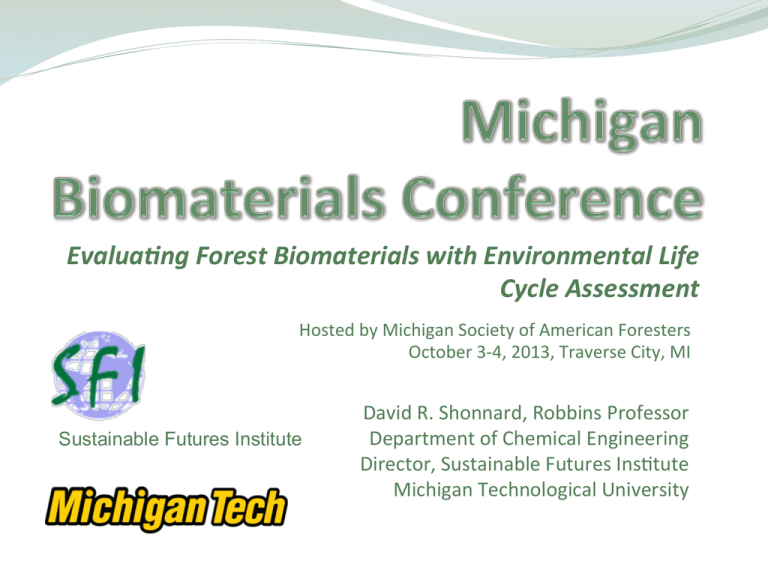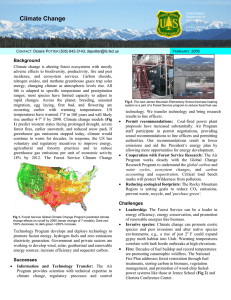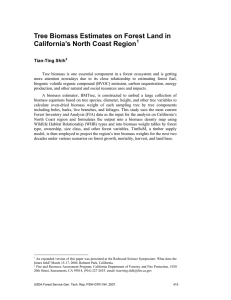Keynote Presentation
advertisement

Evalua&ng Forest Biomaterials with Environmental Life Cycle Assessment Hosted by Michigan Society of American Foresters October 3-­‐4, 2013, Traverse City, MI Sustainable Futures Institute David R. Shonnard, Robbins Professor Department of Chemical Engineering Director, Sustainable Futures InsKtute Michigan Technological University Overview • Role of MI forests in environmental protecKon and ecosystem services • The importance of forests in global carbon and greenhouse emissions • Case Study: Environmental Life cycle assessment (LCA) to understand impacts of forest products on greenhouse gas emissions. 2 Ecosystems -­‐ Management Water Quality/ Quan1ty Climate Mi1ga1on Air Quality Biodiversity Human Communi1es Primary Produc1on Support Processes Soil formaKon, biogeochemical cycles, water purificaKon Image credit: 3 Case Study: Climate and Forests From http://www.bom.gov.au/info/climate/change/gallery/index.shtml CO2 CO2 4 Global Forest Data Sandra Brown http://www.fao.org/docrep/w0312e/w0312e03.htm (50° to 75° N and S) (25° to 50° N and S) world's forests contain more than 55 percent of the carbon stored in vegetaKon most vegetaKon biomass is in the tropical zone, but most soil C is in the boreal zone US has more temperate zone forest C than all other countries and regions (0° to 25° N and S) C fluxes are posiKve (uptake by land) in temperate and boreal zones due to re-­‐growth aYer prior human disturbances (harvesKng), but negaKve in the tropical zone (deforestaKon) 5 Summary of Forests and Climate • Environmental effects of forest products must account for changes in condiKon of forest lands • Environmental effects will also depend on acKviKes Ked to harvesKng, processing, transporKng, and storing biomass • Increasing forest products may displace other products in the industrial sphere, with addiKonal effects 6 Life Cycle Assessment Method • The boundary of the analysis is the “cradle-­‐to-­‐grave” product system including; forest carbon, product chain, and displaced product systems (cement, steel, fossil fuels) 7 Forest Product System 8 Life Cycle Assessment Uses • Understand a product • • system’s effect on the environment Minimize environmental impacts LCA can be use to support product declaraKons on environmental benefits compared to other products 9 Case Study: Biofuels from MI Forests Dr. Jiqing Fan, Postdoc, SFI (MTU), Dr. Robert Froese, SFRES (MTU) • A generic forest-­‐based biofuels pathway Biomass ProducKon TransportaKon Feedstock Conversion Fuel DistribuKon End Use Biomass Produc1on: Model changes in C stocks on MI aspen forests over Kme from more intensive harvesKng compared to business as usual (BAU) Conversion: Model cellulosic ethanol and pyrolysis bio-­‐oil C Accoun1ng: Model GHG emissions for use of fossil fuels along the pathway as well as emissions of biogenic CO2 from changes in forest C stocks 10 Carbon Budget Model for the Canadian Forest Sector (CBM-­‐CFS3) Table: Carbon pools in the CBM-­‐CFS3 and pools recommended by IPCC GPG CBM-CFS3 pools IPCC GPG pools Merchantable & bark (SW, HW) Other wood & bark (SW, HW) Foliage (SW, HW) Fine roots (SW, HW) Coarse roots (SW, HW) Snag Stems DOM (SW, HW) Snag branches DOM (SW, HW) Medium DOM Aboveground fast DOM Aboveground very fast DOM Aboveground slow DOM Belowground fast DOM Belowground very fast DOM Belowground slow DOM Aboveground biomass Aboveground biomass Aboveground biomass Belowground biomass Belowground biomass Dead wood Dead wood Dead wood Litter Litter Litter Dead wood Soil organic matter Soil organic matter 11 Forest C dynamics simula1on • The CBM-­‐CFS model esKmates the aboveground • • • • • biomass from the merchantable Kmber volume based on yield-­‐to-­‐biomass equaKons developed by Boudewyn 2007 The CBM-­‐CFS then esKmates aboveground C increments (0.5 kg C/kg biomass) Once the aboveground C increment is esKmated, belowground biomass and C increment are calculated using equaKons from Li 2003 The model esKmates biomass turnover to represent biomass mortality using annual turnover rate. Then the model uses liderfall transfer rates to assign C to different DOM pools. DecomposiKon is modeled by a temperature-­‐dependent decay rate that determines the amount of organic mader that decomposes in a DOM pool every year. The CBM-­‐CFS3 uses a simulaKon iniKalizaKon procedure that links biomass, DOM dynamics and historic disturbance regimes at the beginning of a model run. Figure: C flow between biomass and DOM pools in the CBM-­‐CFS3 Adapted from Kurz 2009 12 Aspen harves1ng Table: Current age distribuKon (in ha) of aspen in Michigan (USDA 2013) age Aspen/birch group 0-­‐19 20-­‐39 40-­‐59 60-­‐79 80-­‐99 100-­‐119 Total 225,000 311,000 385,000 278,000 87,000 13,000 1,299,000 • Growth curves are the fundamental data for forest C modeling • The red curve represents “business as usual” (BAU) aspen growth and harvesKng for exisKng uses (pulp and paper,..) • The green curve is an improved growth curve for aspen represenKng acKve best pracKce management Figure: Growth curves of aspen in Michigan 13 Harvested biomass: Business as usual (BAU) and intensive (INT) harves1ng • In the BAU scenario, 7200 ha of aspen is assumed to be harvested every year to match FIA data, while INT scenario doubles the areas to 14400 ha. • The extra biomass harvested in the INT scenario addiKonal to the BAU scenario (205 million metric ton) is used for biofuel and bioenergy producKon. Figure: Total biomass harvested in the BAU and INT scenarios over 250 years 14 Forest C Stocks in Aspen Figure 7: Ecosystem C stored in the BAU and INT scenarios 15 Direct land use change (dLUC) CO2 emissions of biofuels and bioenergy Figure: dLUC of biofuel and bioenergy over 250 years 16 Life cycle GHG emissions of biofuels and bioenergy GHG emissions w/o LUC: • EtOH: -­‐3.74 g CO2 eq/ MJ (GREET 2012) • Pyrolysis oil: 16.35 g CO2 eq/MJ (Fan, 2012) • Pyrolysis electricity: 130.8 g CO2 eq/kWh (Fan, 2012) Figure: GHG emissions (w/dLUC) of EtOH, pyrolysis oil and electricity over 250 years, comparing to their petroleum counterparts 17 Bioenergy system total emissions ΔFC(t): change in forest carbon at any time (t) due to biomass harvest for bioenergy, calculated by 𝐶↓𝑒𝑐𝑜𝑠𝑦𝑠𝑡𝑒𝑚↑𝐼𝑁𝑇 (Mckechnie, 2011) Emissions from fossil fuels displaced are substracted from the biofuel system emissions from the previous slide. A GHG emissions “debt” is overcome between 50 and 100 years in the future. In the short term, MI forest-­‐based biofuels from INT harvesKng emits more than fossil fuels −𝐶↓𝑒𝑐𝑜𝑠𝑦𝑠𝑡𝑒𝑚↑𝐵𝐴𝑈 . GHGbio: net savings of GHG emissions for biofuels and bioenergy from displacing fossil fuel, calculated by ∑1↑𝑡▒(𝐺𝐻𝐺↓𝑏𝑖𝑜 −𝐺𝐻𝐺↓𝑓𝑜𝑠𝑠𝑖𝑙 ) . Figure: Total GHG emissions of forest-­‐based biofuels system 18 Summary on Forest-­‐Based Biofuels • Biofuels produced from forest resources that are harvesKng more intensively than the normal harvest level will incur direct land use change emissions of CO2 • The dLUC emissions will cause a C debt early in the producKon cycle that range over many 10s of years. • Improved management of forest for such intensive harvests can moderate or eliminate the dLUC emissions • Forest plantaKons on abandoned agricultural may offer benefits for biofuels producKon by eliminaKng the C “debt” 19 LCA of Forest Products for Homes PNW Forest C Pools for Different Harvest Rota&ons CORRIM (2004) 20 LCA of Forest Products for Homes Short-­‐ and Long-­‐Lived C Pools, Displaced energy, Concrete Sub. CORRIM (2004) 21 Conclusions • Producing products from forest resources can have long-­‐ term benefits to the environment (C storage in products, avoided emissions from fossil fuels,..) • Environmental life cycle assessment (LCA) is a comprehensive method to understand impacts across a product’s life cycle • LCA of forest products must include these key features; Ø Modeling of forest management with respect to C storage and other environmental effects (biodiversity, water quality, …) Ø Modeling of the acKviKes and process for culKvaKon, harvest, transport, and manufacturing processes Ø End of life processes such as recycle and disposal Ø SubsKtuKon of equivalent products in the market 22


